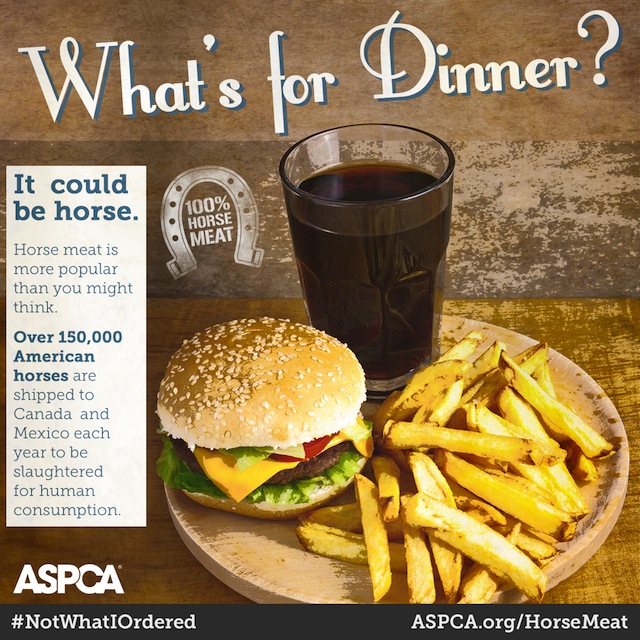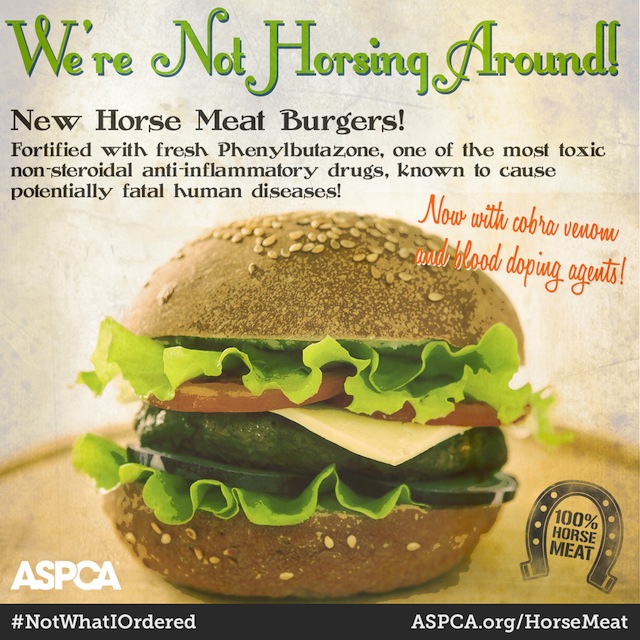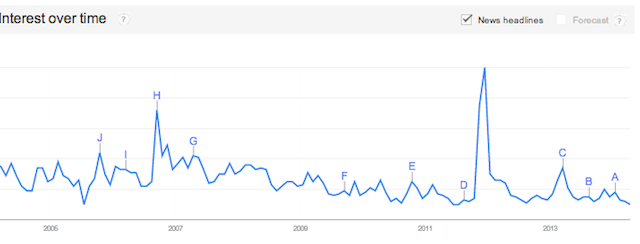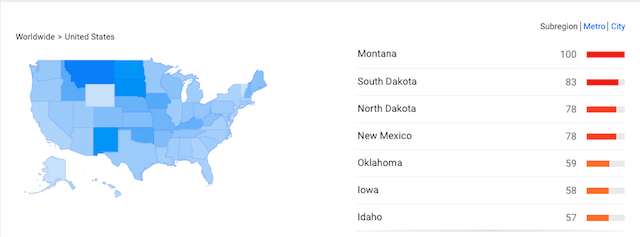ASPCA Launches #NotWhatIOrdered Horse Meat Rejection Campaign
- March 10, 2017
- ⎯ Fran Jurga
If a lion in Africa and a gorilla in Cincinnati can do it, can horse-related issues do it, too? To some extent, Barbaro, Ruffian and Eight Belles did it. “It” is a shift in consciousness of a large portion of the US population.
Those three horses raised the awareness of the public to the problems of horse racing, as well as the need for more horse health research. They also galvanized the horse industry to do more to protect horses, improve racing surfaces, keep count of fatalities and injuries, eliminate some forms of medication, and look at the role of horseshoes, stress, and conditioning along with the obvious orthopedic issues of catastrophic equine breakdowns on the racetrack.
But what horse or pony is the face of equine slaughter?

Horse slaughter is about the anonymous horses, the unwanted, the horses caught in the void. The poster child of the movement is the mass of unknown, unloved horses who are trucked to the only place that wants them, in the end: a slaughterhouse in Canada or Mexico.
For that reason, the anti-slaughter movement is challenged to make itself “real” in the minds of the public. Slaughter-bound horses may whiz buy you in long trailers; those trailers might contain a horse you once rode or even owned or bet on at the track. But they don’t have names or faces anymore. Horses like Snowman and so many others who stood on the brink of being sold for slaughter are heroes for all they accomplished in their second lives, but they don’t always succeed in initiating public action to support the cause of the horror they avoided.
Wild horses, equine slaughter, urban carriage horses, Walking horse soring, and aggressive riding in the FEI disciples can (sometimes) galvanize a wider public than just horse owners to voice an opinion, donate funds, and pressure public and organizational officials to impact change.
To do that, organizations perceive that they must create a “viral-ready” campaign and put it in the right hands. Once available, it will magically just “go viral”. Won’t it? In the case of horse issues, the audience is relatively small. We’re already talking to each other. How does a charity or cause reach a wider audience, a big enough group to truly turn up the volume?
“Viral-ready” planning requires following a proven recipe that mixes slogans, hashtags, infographics, celebrity endorsements and the crucial strength of linking an issue with the identity of a single organization that, at the same time, benefits from publicity, web traffic and beyond-the-single-cause fundraising, membership and merchandising.

Enter the ASPCA‘s latest campaign to stop horse slaughter once and for all in the United States– #NotWhatIOrdered, for short.
Today the nation’s highest-profile animal advocacy charity launched a pre-packaged social-ready campaign with the hope that it will re-vitalize a climate of protest against horse slaughter in the United States.
It contains plenty of clever one-liners, but equestrians and horse advocates may well ask, “Where’s the horse?” And, ultimately, where are the facts beyond just the fear that you might be served horse meat at a fast food restaurant?
Instead of appealing to animal-friendly emotions by focusing on the lives and welfare of horses, the campaign’s shareable visuals appeal to our taste buds. The hashtag and its supporting materials clearly ask us to reject eating horsemeat as an avenue to ending horse slaughter once and for all in the United States. Very little horse meat is sold in the United States, but the visuals suggest that a horse burger is an option, or a likely risk. They are asking us to fear horsemeat both because we might unknowingly eat it and because of the contaminants it may contain from racehorse medication and drugging.

An email from the ASPCA describes the campaign as “a viral movement focused on creating awareness about the sad reality that over 150,000 American horses are being sent to Canada and Mexico every year to be slaughtered for human consumption.” (In reality, USDA totals list numbers well under 150,000 per year since 2013.) ASPCA graphics don’t show any horses, dead or alive. Instead, they show fast food and supermarket images.
The issue of horse slaughter, unwanted horses, racehorse medication, and horse rescue are all important issues. Can you distill them all down to a single hashtag? Can you take the horse out of equation and replace it with food-related insecurities that are real fears for many Americans?

The ASPCA campaign’s home page on the charity’s website invites the public to sign a petition. But the petition is missing. A clickable link asks the visitor to “take the pledge” but you can’t read the pledge before you take it.
Compare this leap of faith with a press release issued by ASPCA on May 16, which states the facts, gives the background, and explains what went on in Washington, DC this spring when the U.S. Senate Appropriations Committee once again voted to marginalize horse slaughter by not including any funding for federal inspectors in the 2017 Agriculture Appropriations bill. (An identical amendment was approved by the House Appropriations Committee in April.)
In April, the ASPCA shared the results of an Edge opinion poll on horse ownership and adoption. While the survey only tested the opinions of 3,036 U.S. adults, the data are laid out in a factual, understandable way.

In 2016, its 150th anniversary year, the ASPCA has a chance to remind us why it has survived all these years and why it has led the way on so many animal-related issues in the past. It also has the potential to influence public opinion and widen the base of support for all equine-related welfare issues, including horse slaughter.
But the ASPCA and anyone who tackles this issue owes it to horses and the horse-owning public to make it clear that this is a complex issue with many angles. It affects many people as well as many horses. At this point in its political reality, it can’t be summed up in a single hashtag, especially when there’s not a horse in sight. It’s a broader issue than a colorful graphic that flashes by you in an Instagram feed.

How do you make people stop and think? How do you work toward a solution for the horses at risk who are so desperate for one? The viable future for horses in the USA needs a lot more thought than a split-second decision to “like” or “share”.
The ASPCA and charities like it have the resources and power to build a better-informed public, to arm politicians with facts and to unite policy advocates under a common vision until we have guaranteed a brighter, safer future that both humans and horses will gratefully–and gracefully–like and share in a much more meaningful way.





